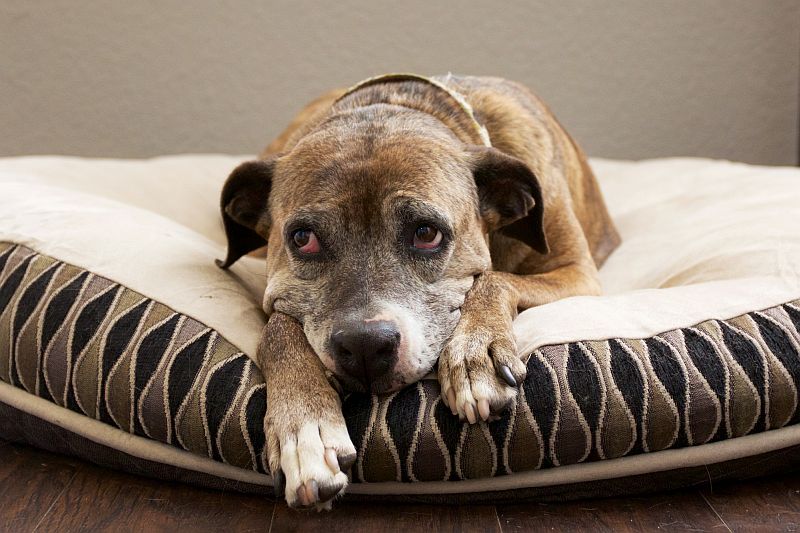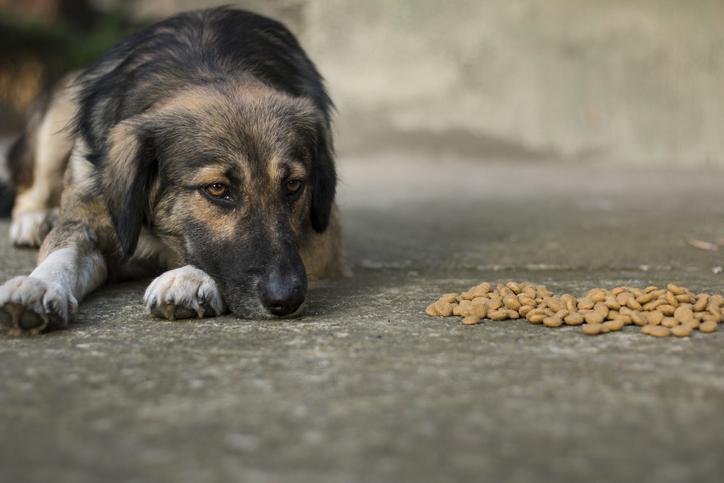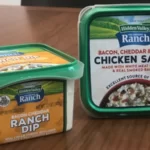
Food is a necessary component of life. Without it, everybody would fall ill and eventually pass away. Your dog must consume a balanced and sufficient diet in order to remain healthy and robust. But what if your dog refuses to eat dog food when he ought to?
How long can a dog go without eating? Every dog is unique and there is no set number of days that is “safe” for dogs who have gone on hunger strike, however most healthy dogs can contend with 3 days without eating food as long as your pet drinks water. A change in appetite, however, can be a sign of something very serious, so if you are unsure, schedule an appointment with your veterinarian.
Please continue reading so I can show you more information.
Table of Contents
Can A Healthy Dog Go Without Food For How Long?
Although this number is only accurate if your dog is still getting enough water, most healthy dogs can go up to five days without eating. Some can even go up to seven days without, but you should never wait that long to take your dog to the vet.
How Long Can A Weakened Dog Go Without Food?
If your dog isn’t in the best of health, going without food for five days will probably make him worse off. The longest you might be able to go without food is three days, and even less time without water.
Why Your Dog Isn’t Eating
Why your dog isn’t eating is the most important question you need to ask as a dog owner. Your pet may not be eating for a variety of reasons. A simple diet change may be able to address some of these causes, but others may be much more difficult to address than you might realize. So here are some potential problems that might be keeping your pet from eating as usual.
Medical Issues
Your dog may refuse to eat as a result of certain medical conditions that cause them to lose their appetite. Stomach upset, gingivitis, and other infections might be some of the most typical medical conditions.
Depression
A depressed dogs may exhibit any or all of these symptoms:
- The playfulness and general activity levels of depressed dogs are lower than those of healthy dogs.
- They might alter how they go to bed. This could indicate that your dog sleeps all night, only during the day, or simply does not get enough sleep. Over time, this may lead to irritability.
- disregard for things they used to enjoy. Fido may not be pursuing the treats he used to crave so fervently. Has he yet to use his brand-new chew toy? If so, he might be depressed.
Remember that these symptoms can also be found in other illnesses. Going to the veterinarian and having all other possibilities eliminated first is the best course of action. They’ll likely follow up by asking you questions about how your home life has changed, how frequently you spend time with your dog, etc. If your dog is diagnosed with depression, the vet may advise taking particular medications or starting a new treatment plan to help him recover. The best place to start is always by discussing your dog’s diet and eating habits with your veterinarian.
Anxiety
Dogs who are anxious are often a little more erratic, and their actions will show it. These include:
- Aggression
- Trembling
- Barking
- Growling
- Hiding
- Tucking his tail between his legs
- Trying to run away constantly
- Inability to go outside without panicking
- Aversion to being touched
These are all fairly typical indicators of your dog’s anxiety, along with a stifled appetite. When this happens, you will visit your veterinarian to determine the best course of action. You may receive medication from them or additional advice on how to keep your dog calm in the future. These may include:
- more time spent with your dog. Being separated from their owner(s) for an extended period of time causes dogs to experience anxiety more frequently than other types of anxiety. If you work or travel a lot, this occurs especially frequently.
- allowing them some separation from other people and loud noises. Your dog should have a place in your house that he can go to when he feels overwhelmed by the outside world. Give him a roomy crate to sleep in and turn down the lights. Also, keep the room quiet.
- Your dog might be so afraid because he was never properly socialized to the outside world. Early socialization is important because later on, your dog will find it more challenging to get along with other people and animals.
Cognitive Problems
Certain canine cognitive disorders impair their capacity for clear thought and comprehension, which may have an impact on how they behave when it comes to eating. For instance, just like in humans, it is known that depressive and anxious times in dogs can result in an absence of appetite.
Your Dog Is Choosy
Picky eaters include dogs. Until you discover the food your dog prefers, you might want to try a variety of foods. This could entail giving your pet enough time and spending more on dog food.

What Must You Do If Your Dog Refuses To Eat?
As mentioned, there are numerous potential causes for your dog’s refusal to eat, and these vary from dog to dog. To identify the issue and explore potential remedies, you must carefully examine your dog. In light of that, here is what you ought to do in the event that your canine companion observes a prolonged fast.
Take It Easy
When your dog skips a meal, do not become alarmed. Your pet might experience a brief loss of appetite, similar to how humans do, without necessarily experiencing long-term consequences. You shouldn’t worry about the problem if the dog exhibits no abnormalities. Going without food for one or two days could be problematic. On the other hand, you should act right away if the fast lasts longer than two days.
Find Out Why Your Dog Is Not Eating
Examine any changes in your dog’s behavior, dog food, and body for any indications of illness to determine what might be preventing them from eating. It will be simpler to look for a solution if you can identify the root of the problem.
Get Their Favourite Dog Food
Pickiness is one of the more straightforward causes to address. For instance, you could attempt to purchase your dog’s preferred food and, if they start eating, make sure you have enough for them. You can trust that your dog will adore Iams’ premium food because we work hard to produce the highest quality dog food possible.
Encourage Them To Eat
According to research, sick dogs who eat more frequently recover more quickly and effectively. So make an effort to get your dog to eat. They might be piqued by something besides their typical kibble. To help their digestion, try some bland food like boiled chicken breasts or vegetables like pureed squash.
There are many reasons why dogs won’t eat, and they aren’t always related to underlying medical issues. As long as your dog is adequately hydrated, it’s usually not a problem if they miss one or two meals. However, you must urgently take your dog to the veterinarian if they have gone days without food. Your veterinarian will identify any potential health problems your dog may have and give you advice on the best ways to take care of your puppy.
Take Your Dog To A Vet
The final resort would be to take your dog to the vet if none of the other options were successful. You will be able to diagnose your dog’s condition in this way.
Read about: Can You Freeze Freshpet Dog Food?
When Should I Become Concerned If My Dog Isn’t Eating?
It’s time to be concerned if your dog goes longer than 48 hours without eating or drinking. If your dog exhibits additional symptoms of illness, such as vomiting, diarrhea, lethargy, or weakness, you should also call your veterinarian.
In order to determine potential causes of your dog’s lack of appetite, your veterinarian will enquire about your dog’s medical history. Your dog will then undergo a thorough physical examination from your veterinarian, who will be looking for any illnesses that might be affecting your dog’s appetite. Your veterinarian will probably suggest laboratory testing if there are no obvious causes for the inappetence discovered during the examination. Depending on your dog’s medical history, physical examination, and your veterinarian’s clinical suspicions, these tests may include blood tests, urinalysis, x-rays to rule out potential pain sources, or other diagnostic tests.
Your veterinarian will suggest the best course of action to address the underlying problem if they can figure out why your dog isn’t eating. For instance, if your dog is not eating because of nausea, your veterinarian may give them an anti-nausea injection or send them home with oral medication. Your veterinarian may advise a dental cleaning and/or dental extractions if your dog is not eating because of excruciating tooth pain.
If no underlying cause for your dog’s anorexia can be identified, your vet may recommend an appetite stimulant to help increase your dog’s appetite. Your veterinarian may also collaborate with you to create a feeding schedule that includes palatable (tasty) food that is rich in calories and nutrition.
FAQs
How Much Time Can A Dog Survive Without Water?
Dogs can go longer without food than they can without water because they dehydrate very quickly.
“If your pet does not drink anything for a full day, you should call your veterinarian,” Telling The Dodo was Dr. Bailey. “Severe dehydration could result from this. A pet that isn’t drinking may be seriously ill and needs to be seen right away.”
If your pup isn’t drinking, look out for these signs of dehydration in dogs:
- Panting
- Lethargy
- Loss of appetite
- Dry nose
- Dry, sticky gums
- Pale gums or bright red gums
- Thick saliva
- Loss of skin elasticity
How To Get Your Dog To Drink Water
Avoid the temptation to sample flavored water or to serve electrolyte water. These issues could cause your pet’s diagnosis and treatment to be delayed.
There are some other things you can do to try to get your dog to drink and to keep him hydrated, such as:
- Toss some wet food to your dog. He won’t become too quickly dehydrated thanks to the food’s high water content.
- Your dog’s dry food should be given some water.
- Give your pup ice.
- Test out a dog water fountain.
Try some of these tricks if your dog hasn’t been eating or drinking for only a short while. However, you should definitely call your veterinarian to make sure your dog isn’t ill if he hasn’t eaten or drunk anything for a full day.
Final Words
You might realize eventually that your dog isn’t eating. And a number of factors can contribute to this. But before you do anything else, you should take your pet to the doctor for an examination and diagnosis. Find the cause of your dog’s illness as soon as possible rather than waiting until your dog is malnourished and it is too late. Ideally, you should only hold off for 48 hours. If the behavior continues, you may want to make sure your dog is getting enough fluids, such as water, before going to your local vet clinic for advice.
Thank you for reading.






